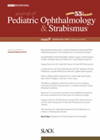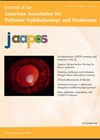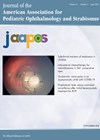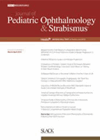
Journal Reviews
Association of subconjunctival haemorrhage with non-accidental injury
This study assessed the frequency and nature of diagnostic work-ups in infants with subconjunctival haemorrhage (SCH), the incidence of occult injuries among these patients and the factors that may have influenced the work-up. This was a retrospective secondary analysis of...
Scheimpflug imaging in paediatric glaucoma
The authors undertook this study to report the corneal tomographic characteristics of eyes that had surgery for controlled primary congenital glaucoma (PCG) compared to a control group. The study included 44 eyes of 27 children (18 males) having surgery for...
Changes in corneal endothelial layer after strabismus surgery
The purpose of this study was to investigate the changes in the corneal endothelial layer by specular microscopy after surgery in patients with horizontal and oblique strabismus. Eighty-three eyes of 56 patients were evaluated prospectively. There were three subgroups: one...
Visual fatigue associated with greater online digital use during the pandemic
The purpose of this study was to subjectively examine the degree of visual fatigue in children attending online classes during the pandemic and objectively evaluate accommodation and vergence of these children. The study was undertaken from July-August 2020 and recruited...
Pilot trial of virtual reality to treat amblyopia beyond the age of seven years
A pilot double-blind randomised controlled trial is presented. Patients were required to be between seven and 38 years of age, have a diagnosis of anisometropic and / or strabismus unilateral amblyopia, visual acuity in the amblyopic eye between 0.3-1.0 LogMAR...
At what age do children start to negatively judge ptosis?
The authors present a cohort study to assess for the presence of peer bias against ptosis. Recruitment took place in nursery and primary schools, of children aged three to six-years-old. An exclusion criterion was the presence of a visible ophthalmic...
Factors leading to loss to follow-up after strabismus surgery in children.
One hundred and fourteen patients were identified as lost to follow-up between 2014 and 2020, representing 16% of paediatric strabismus surgery performed during this time period. The authors specifically defined lost to follow-up as not attending follow-up appointments between three...
Accuracy of ASOCT muscle insertion measurements
Anterior segment optical coherence tomography (ASOCT) is a non-contact imaging method that can provide accurate measures of extraocular muscles to limbus insertion distances. The authors evaluated the accuracy of ASOCT for locating horizontal extraocular muscle insertions after strabismus surgery in...
Use of pattern-reversal VEP in congenital Zika syndrome (CZS) assessment
The authors conducted pattern reversal visual evoked potential (PRVEP) in children with congenital Zika syndrome (CZS) and report the correlates with visual acuity, fundus alterations and severity of microcephaly at birth. This was a cross-sectional study of 37 children with...
Paediatric emergency presentations in an urban centre
The authors aimed to evaluate aetiologies in paediatric patients presenting to the Wills Eye Emergency department (USA) with particular emphasis on trauma. This was a retrospective review of one-year hospital data; 1136 paediatric patients, 57.4% male, 50.7% white, 36.8% black,...
Surgical outcomes for constant and intermittent exotropia
This study evaluated the surgical results for constant and intermittent exotropia to investigate the factors that might influence the surgical results in a Scandinavian population. This was a retrospective study from 2011-2015 during which time 633 patients had strabismus surgery...
Successful laceration repair with the Mini Monoka stent
The aim of this study was to evaluate demographic data, clinical profile and factors responsible for success of anatomical and functional outcome of canalicular laceration repair with the Mini Monoka stent in children younger than 10 years. This was a...








